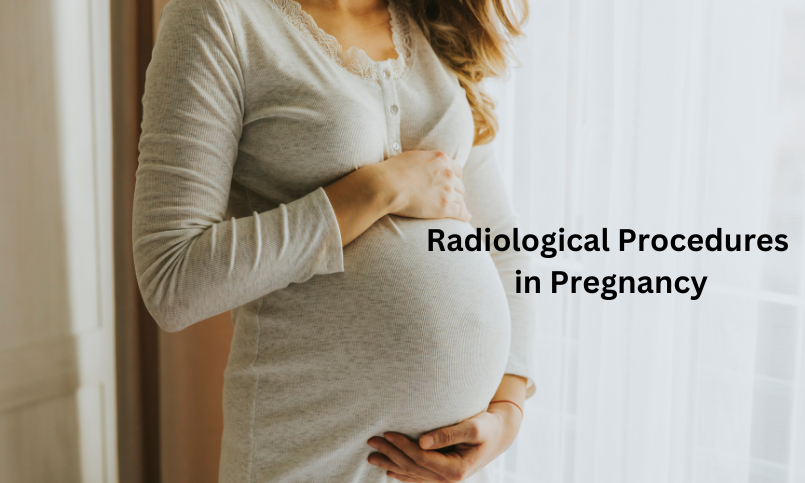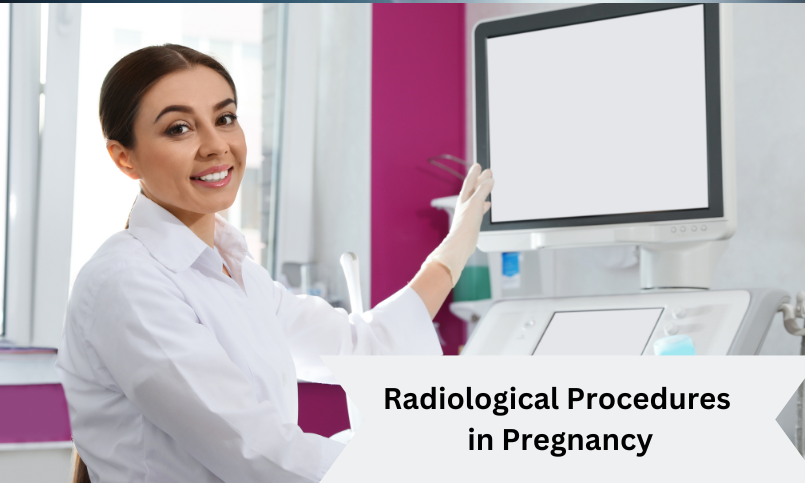Introduction
During pregnancy, there are a number of health issues that women may have that require radiological procedures. It also raises questions regarding the potential risks to the developing fetus. X-rays, CT scans, and MRIs are the radiological procedures necessary for diagnosis and treatment of medical issues during pregnancy. We will discuss safety recommendations, effects of radiological procedures in pregnancy on mother and their unborn children in this post.
What are Radiological Procedures?
A number of imaging modalities are used in radiological procedures to look into internal structures, diagnose diseases, and direct therapies. Typical radiological procedures in pregnancy consist of:
- X-rays
Ionizing radiation is used in X-rays to provide images of organs, tissues, and bones. They are frequently used to monitor specific medical disorders, identify fractures, and assess the chest, abdomen, and skeletal system. - Computed Tomography (CT) scan:
CT scans produce finely detailed cross-sectional images of the body by combining computerized imaging and X-ray technology. They are helpful in the diagnosis of a variety of illnesses, including as vascular disorders, cancer, and trauma. - Magnetic Resonance Imaging (MRI):
MRI scan creates finely detailed images of body’s soft tissues, organs, and structures using magnetic fields and radio waves. They are especially helpful for assessing the abdomen, joints, brain, and spinal cord.
- Ultrasound:
High-frequency sound waves are used in ultrasound imaging to create real-time images of inside of organs, tissues, and fetal development. It is frequently used in prenatal care to track the growth of the fetus, check placental health, and identify anomalies.
- Nuclear Medicine:
To see organ function, blood flow, and metabolic processes, radioactive tracers are given out during nuclear medicine operations. These tracers are then detected by specialized cameras. Thyroid scans, cardiac stress tests, and bone scans are common nuclear medicine procedures.

Safety Considerations for radiological procedures in pregnancy
Many factors, like type of imaging modalities, radiation dose, gestational age, and potential dangers to the fetus, affect how safe radiological procedures during pregnancy are. Healthcare providers must assess the procedure’s benefits against any potential risks to the mother and unborn child. Important safety factors to take into account for radiological procedures in pregnancy include:
- Ionizing Radiation:
X-rays and CT scans that use ionizing radiation have the potential to harm DNA. And raise the risk of birth defects, pediatric cancer, and abnormalities in the development of the baby. The danger is dependant upon the specific organs exposed during the surgery, the gestational age, and the radiation dose.
- Fetal Development:
During organogenesis stage, which occurs between Week 2 – week 7 of pregnancy. Organ systems are growing, the developing fetus is most vulnerable to harmful effects of radiation. Radiation exposure during this important phase can impair normal development and raise the possibility of birth defects.
- Gestational Age:
Radiation exposure chances will decrease as pregnancy duration increases.. Since the developing fetal organs are less vulnerable to radiation-related harm. Even though, there is a chance that some radiological procedures. In later stages of pregnancy, some of them can be harmful, especially those involving high doses of radiation. - Imaging Modalities:
Certain radiological treatments, like MRIs and ultrasounds, don’t involve ionizing radiation and are safe to undergo while pregnant. During the first trimester, these modalities should be used to assess the state of the mother and the fetus.
- Shielding and Positioning:
When taking X-rays or CT scans during pregnancy, medical professionals take all precautions possible to reduce the radiation exposure to the fetus. This can involve wrapping lead aprons around the abdomen/stomach or positioning the patient in a way to reduce scatter radiation.
- Consultation and Informed Consent:
Pregnant women should be informed about the advantages and disadvantages of radiological procedures by healthcare professionals. They should also go into detail about any potential effects on the health of the mother and fetus. Before doing any imaging investigations of a pregnant woman is, her informed consent should be taken.
Guidelines & Recommendations for radiological procedures in pregnancy
Safety guidelines for use of radiological procedures during pregnancy have been developed by number of professional organizations and regulatory bodies. The purpose of these guidelines is to provide appropriate diagnostic and therapeutic approaches. While also making sure that pregnant women safety is taken care of. Important recommendations consist of:
- American College of Radiology (ACR):
Their Guidelines for Imaging highlights the significance of reducing radiation exposure while a woman is pregnant. They offers suggestions for deciding on suitable imaging modalities, maximizing radiation exposure. And discussing the advantages and disadvantages of radiological procedures with obstetricians and radiologists.
- The American College of Gynecologists and Obstetricians (ACOG):
Their Guidelines for diagnostic imaging during pregnancy are outlined in ACOG Committee Opinion No. 656. They recommends the use of ultrasonography as the preferable imaging modality whenever possible. It advises against having unnecessary radiological procedures done during the first trimester. Unless necessary from a therapeutic standpoint, especially ones that involve ionizing radiation. - European Society of Radiology (ESR):
Evidence-based guidelines for use of imaging modalities during pregnancy are provided by ESR Guidelines on Radiological Procedures in Pregnancy. It focuses on how important it is to communicate with other healthcare experts, optimize dosage. And conduct individual risk assessments to guarantee the safety of patients. - International Commission on Radiological Protection (ICRP):
The protection of the embryo and fetus during exposure to diagnostic medical procedures is covered in ICRP Publication 84. It suggests avoiding needless radiological procedures, especially in the first trimester. And limiting the fetal radiation dosage throughout pregnancy at less than 100 mGy.
- National Institute for Health and Care Excellence (NICE):
Guidelines for the identification and treatment of maternal diseases during pregnancy are provided by NICE Clinical Guideline CG132. It points to how important it is to consider the advantages and disadvantages of radiological treatments, improve imaging methods. And involve interdisciplinary teams in the decision-making process.
Management of Radiological Procedures in Pregnancy:
When radiological operations are considered to be necessary during pregnancy. Healthcare professionals adopt many safety measures to reduce potential risks to the mother and fetus. This should consist of:
- Individualized Risk Assessment:
A complete risk assessment is carried out by healthcare professionals. Taking into consideration factors such as gestational age, maternal health, clinical indications for imaging, and possible fetal concerns. - Radiation Dose Optimization:
Imaging methods are customized by technicians and radiologists to reduce radiation exposure while preserving diagnostic image quality. To protect the fetus, this may include modifying exposure parameters, applying low-dose approaches, and using shielding methods. - Alternative Imaging Modalities:
When monitoring maternal and fetal status throughout pregnancy, medical professionals favor non-ionizing imaging modalities like MRI and ultrasound. Without exposing the fetus to ionizing radiation, these methods offer important diagnostic information.
- Multidisciplinary Consultation:
Obstetricians, radiologists, and other medical professionals together analyze advantages and disadvantages of radiological techniques. So that they can make well-informed, personalized decisions about patient care.
- Fetal Dose Monitoring:
During imaging operations, radiologists and medical physicists keep an eye on the fetal radiation dose. To make sure that exposure levels stay within safe bounds and don’t cross established norms.
Conclusion
Now you know about radiological procedures in pregnancy & preacuations related to it.
Also Read : 5 weeks pregnant ultrasound
Faq’s about radiological procedures in pregnancy
Q1: What is radiology scan during pregnancy?
Ans: X-ray, Ultrasound and CT scan are radiology scan done during pregnancy.
Q2: What is radiology used for in pregnancy?
Ans: To find out any medical problem in mother or fetus.
Q3: Is Radiological Procedures safe in pregnancy?
Ans: Yes, if done by strictly following the guidelines, with radiation exposure less than 45 mGy.

